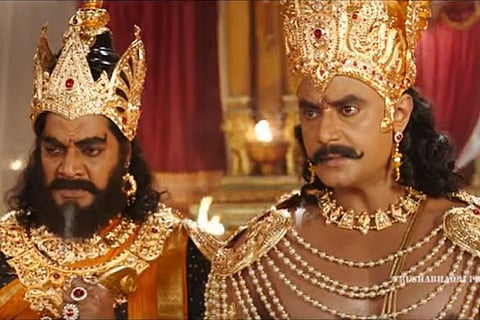

The Mahabharata needs no introduction. One of the greatest epics of all time, the story spans over one lakh shlokas, or over two lakh verses. The original work, written by Veda Vyasa in Sanskrit, has about 1.8 million words. The Mahabharata has been written in 18 books, called parvas.
Muniratna’s Kurukshetra, directed by Naganna, deals with the Sabha Parva in the first half and, as the title suggests, the Kurukshetra war – involving bits taken from five parvas such as Udyoga, Bhishma, Drona, Karna and Shalya Parva – in the second half.
The 10th century Kannada poet Ranna’s magnum opus Gadayuddha (The Duel of Maces), in its undertones, portrays Duryodhana (Suyodhana) as the real hero of Mahabharata. Muniratna’s Kurukshetra is a visual tribute to the 10th-century classical text. Duryodhana, who is mostly seen as the villain, is not the pinnacle of evil as he's often made out to be. He had his fair share of vices, but he had a lot of virtues as well, particularly in how he took a stance against caste discrimination. When Karna challenges Arjuna for a duel, he is shooed away because Karna is from a lower caste. Duryodhana goes ahead and makes him equal to Arjuna by crowning him the King of Anga.
Duryodhana maintained a lifelong friendship with Karna and this bond is one of the highlights of Kurukshetra. Duryodhana was a fair warrior and unlike Bheema, he did not break the rules of the mace fight in which he finally lost his life. Kurukshetra is an acknowledgement of the righteousness of this prince of Hastinapura.
The three-hour-long epic gives Darshan fans a lot to hoot and whistle for. The makers have been able to include a lot of commercial elements and dialogues to cater to Darshan's fans, without meddling with the plot of the epic. Darshan is undoubtedly the life and soul of Kurukshetra. His body language, his mannerisms, attire and attitude are suited to a mythological character. However, some polish in the language would have taken the movie to the next level.
Two other important characters who deserve a mention are Karna (Arjun Sarja) and Shakuni (Ravishankar), with both providing ample support to Darshan. The vyuha formations - Sarpa Vyuha and Garuda Vyuha - visual effects are outstanding and first-of-its-kind in Sandalwood.
The second half is a visual treat for those who were waiting for a Baahubali from the Kannada industry. What stands out in the film are the war sequences, like Nikhil Kumaraswamy’s 10-odd-minute fight inside the Chakravyuha. His screen presence in these scenes is excellent. He wields swords, shoots arrows and pounces on soldiers like the true hero that Abhimanyu was in the epic. After two average films, Nikhil has finally proved himself. However, Abhimanyu (Nikhil Kumaraswamy) also talks about saving the dignity of his father and grandfather, which was unnecessary. Nikhil’s father and grandfather - politicians in Karnataka - somehow seem to infiltrate all his films.
Another highlight is Bheema and Duryodhana’s climax fight sequence. The last 15-minutes are very gripping, thus setting a new milestone in Sandalwood. The effort put in to create the best sets is quite apparent. The art direction deserves special mention for re-creating the grandeur throughout the film. The entire set put up to create Mayasabha – the hall of illusions – is especially captivating.
However, the film is not without flaws and the most glaring of the lot is the voice sync. Dubbing artistes have saved the day for many actors including Sneha (Draupadi), Sonu Sood (Arjuna) and Danish Akhtar Saifi (who plays Bheema). While their aggression in several scenes does not come across convincingly, the dubbing artists have filled the gap. In the middle of the Kurukshetra war, Dharmaraya (Shashi Kumar) declares "Ashwathama Hathaha, Kunjaraha" a trick used to manipulate Dronacharya. The scene, supposed to be shot with all seriousness, unfortunately, has come out like a joke.
The dialogues in the movie are just average, with many actors not getting the diction right. In several parts, when the Pandavas or Duryodhana address seniors as ‘Mama’ or utter a lengthy dialogue, they remind one of age-old Krishna Sandhana drama.
Another blunder is the usage of the term ‘Jalasamadhi’ instead of 'Jalasthambana'. 'Jalasamadhi' (water burial) translates to freeing one's self from the troubles of life by drowning, whereas Duryodhana, according to mythology, had mastered Jalasthambana vidya by which he was able to stop the flow of water and hence remain deep inside the river for as long as he wanted. 'Jalasamadhi' is used more than once in the climax sequence. A little research would have saved the makers from the embarrassment.
The background music is a big let-down in the first half, but takes an exceptional turn in the second half during the war sequences. Soon after Duryodhana’s entry scene, the music fades out, creating an uncomfortable stillness. The second half has too much going on and is too packed.
All said and done, we're left wondering which part of Kurukshetra 's story Muniratna wrote, as claimed in the film's poster, when it is based on the Mahabharata?
Disclaimer: This review was not paid for or commissioned by anyone associated with the series/film. TNM Editorial is independent of any business relationship the organisation may have with producers or any other members of its cast or crew.